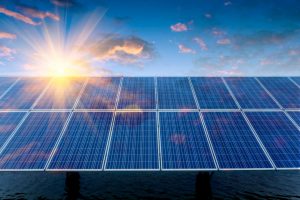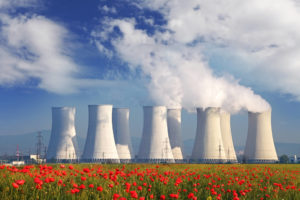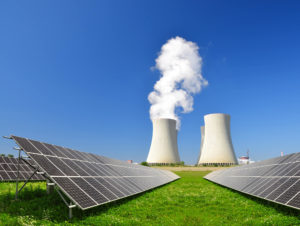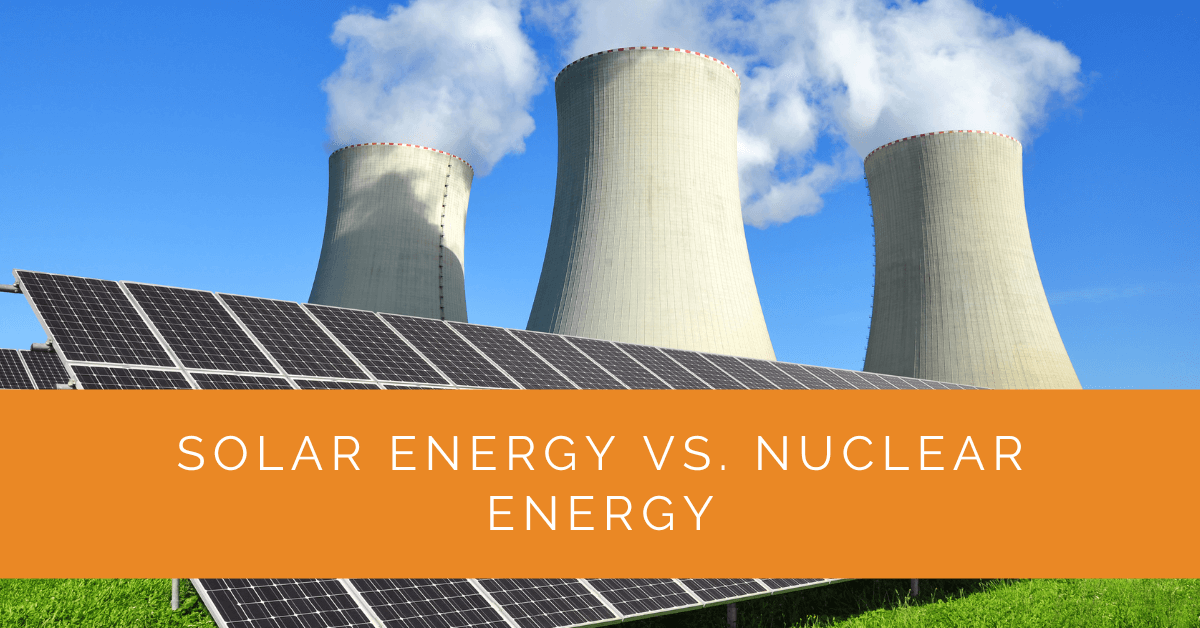In today’s world, the transition to renewable energy sources is more crucial than ever. As we seek sustainable alternatives to fossil fuels, two prominent contenders emerge: solar energy and nuclear power. Both offer unique advantages and face distinct challenges. This article will delve into the details of these energy sources and compare their merits and drawbacks. By understanding the nuances of solar energy and nuclear power, we can make informed decisions about our energy future.
Contents
- 1 Key Takeaways
- 2 Solar Energy: Harnessing the Power of the Sun
- 3 Nuclear Power: Tapping into Nuclear Energy
- 4 Comparing Solar Energy and Nuclear Power
- 5 Case Study: Transitioning to Solar Energy for a Sustainable Future
- 6 Expert Insights From Our Solar Panel Installers About Solar Energy vs. Nuclear Energy
- 7 Experience Solar Excellence with Us!
- 8 Conclusion
Key Takeaways
- Solar energy and nuclear power offer distinct advantages and limitations, but a balanced energy mix that combines both sources can provide a sustainable and reliable energy system.
- Solar energy provides clean and renewable electricity, promoting environmental stewardship and energy independence, while nuclear power offers constant and reliable power generation, contributing to grid stability and meeting high energy demands.
- Integrating solar and nuclear energy allows for a more resilient and flexible energy infrastructure, combining the intermittent nature of solar power with the baseload capacity of nuclear power, leading to reduced greenhouse gas emissions and enhanced scalability.
Solar Energy: Harnessing the Power of the Sun
Solar energy, derived from the sun, has gained significant traction as a clean and renewable energy source. Let’s explore its advantages:
Advantages of Solar Energy
- Clean and Renewable: Solar energy produces electricity without harmful emissions or pollution, making it an environmentally friendly option.
- Reduced Greenhouse Gas Emissions: Solar power significantly decreases the carbon footprint, combating climate change and global warming.
- Low Operational Costs: Once installed, solar panels require minimal maintenance, resulting in lower operational expenses over the long term.
- Potential for Energy Independence: Individuals and communities can reduce their reliance on centralized utility grids by generating electricity on-site.
However, solar energy does have its limitations:
Limitations of Solar Energy
- Intermittency and Weather Dependency: Solar power generation relies on sunlight, making it inconsistent in cloudy or nighttime conditions. Energy storage systems like batteries must ensure a continuous power supply.
- High Installation Costs: The upfront investment for solar panels and associated equipment can be significant. However, falling prices and government incentives are making solar installations more affordable.
- Land and Space Requirements: Generating substantial amounts of solar energy often necessitates large surface areas for solar panel arrays, which can be challenging in densely populated regions.
- Energy Storage Challenges: Storing surplus energy for use during non-sunny periods remains a technological hurdle, but advancements in battery technology are addressing this issue.

Nuclear Power: Tapping into Nuclear Energy
On the other hand, nuclear power harnesses the energy released from nuclear reactions. Let’s examine its advantages:
Advantages of Nuclear Power
- High Energy Density and Continuous Generation: Nuclear power plants produce tremendous energy and can operate continuously for extended periods, providing a stable power supply.
- Minimal Greenhouse Gas Emissions: Nuclear power generates electricity without direct greenhouse gas emissions, creating a cleaner environment.
- Relatively Small Land Footprint: Nuclear power plants require less land than solar farms for the same energy generation capacity.
- Consistent and Reliable Energy Production: Nuclear power is not dependent on weather conditions, ensuring a reliable source of electricity.
However, nuclear power also presents certain limitations:
Limitations of Nuclear Power
- Nuclear Waste Disposal and Environmental Impact: Nuclear waste disposal remains a significant challenge, with concerns over its long-term storage and potential environmental risks.
- High Upfront Capital Costs and Regulatory Processes: Building nuclear power plants requires substantial financial investment and involves complex regulatory procedures, contributing to project delays.
- Safety Risks and Potential Accidents: Although rare, nuclear accidents can have severe consequences for human health and the environment. Strict safety measures and protocols are crucial.
- Limited Fuel Resources: Nuclear power relies on uranium, a finite resource. The extraction and processing of uranium present their environmental concerns.

Comparing Solar Energy and Nuclear Power
Now, let’s delve into a detailed comparison of solar energy and nuclear power across various aspects:
Environmental Impact
Solar energy represents a clean and sustainable energy source, emitting no greenhouse gases during operation. It contributes to reducing our reliance on fossil fuels and mitigating the effects of climate change. Solar power plants have minimal impact on the surrounding environment, as they do not require extensive mining or extraction activities.
Nuclear power, while also low in greenhouse gas emissions during operation, poses challenges regarding waste disposal and potential environmental risks. Disposing of nuclear waste requires careful consideration and long-term storage solutions to prevent negative impacts on ecosystems and human health. Additionally, the extraction and processing of uranium, the fuel used in nuclear power plants, can have environmental consequences.
Reliability and Power Generation
Solar energy’s intermittent nature poses a challenge in terms of reliability and consistent power generation. The availability of sunlight is subject to weather conditions, which can affect the output of solar panels. However, advancements in energy storage technologies, such as batteries, have improved the reliability of solar power by enabling the storage of excess energy for use during periods of low sunlight.
On the other hand, nuclear power provides a constant and reliable energy source. Nuclear reactors operate continuously, generating significant electricity without being dependent on weather patterns. This aspect makes nuclear power particularly suitable for meeting the baseline energy needs of a region or country.
Cost Analysis
When considering the cost of energy generation, several factors come into play for both solar and nuclear power.
Solar energy initially requires a significant investment in installing solar panels and associated equipment. However, the costs have steadily decreased over the years, making solar energy more affordable. Furthermore, government incentives and tax credits can help offset the upfront costs, making solar installations financially viable in the long run.
On the other hand, nuclear power plants have high upfront capital costs due to the complex nature of their construction and the stringent safety measures involved. Additionally, the regulatory processes for building and operating a nuclear facility can be time-consuming and add to the overall costs. However, it’s important to note that nuclear power has relatively lower operational and maintenance costs compared to solar power plants.
To determine the overall cost-effectiveness of each energy source, the levelized cost of energy (LCOE) is often considered. LCOE considers the total costs of installation, operation, and maintenance over the lifetime of the energy generation system. Factors such as fuel costs, construction expenses, and the lifespan of the power plants are all considered in calculating the LCOE.

Energy Independence and Scalability
Solar energy provides an opportunity for energy independence, allowing individuals and communities to generate their electricity. Household and businesses can reduce their dependence on centralized utility grids by installing solar panels on rooftops or in open spaces. This decentralized energy generation promotes resilience and enables individuals to meet their energy needs sustainably.
Nuclear power, on the other hand, operates on a centralized infrastructure. Large-scale nuclear power plants supply energy to a wide area, making it a suitable option for regions with high energy demands. However, this centralized approach may limit the scalability and flexibility of the energy grid, as it relies on a few power plants to cater to a large population.
Solar and Nuclear: A Balanced Energy Mix
Solar and nuclear energy offer unique advantages and limitations, but a balanced energy mix that integrates both sources can create a more robust and sustainable energy system. Solar energy, with its clean and renewable nature, excels in reducing greenhouse gas emissions and promoting environmental stewardship. Solar energy empowers individuals and communities to generate electricity by harnessing the sun’s power, fostering energy independence and resilience. On the other hand, nuclear power provides a reliable and continuous source of electricity, irrespective of weather conditions. It’s high energy density and baseload capacity make it well-suited for meeting the constant power demand.
By combining solar and nuclear energy, we can capitalize on the strengths of both sources and address their respective limitations. Solar power can contribute to reducing the reliance on fossil fuels and mitigating climate change. Its decentralized nature allows for localized energy generation, reducing strain on centralized grids and promoting local empowerment. Meanwhile, nuclear power can offer stability and reliability to the energy grid, providing a consistent power supply even during periods of low solar availability or high demand. By complementing the intermittent nature of solar energy with the continuous output of nuclear power, we can ensure a more balanced and resilient energy supply.
Furthermore, a balanced energy mix that includes solar and nuclear power allows for greater scalability and flexibility. Solar energy can be easily scaled up or down by adding or removing solar panels, making it adaptable to changing energy needs. With its large-scale power plants, nuclear power can meet the energy demands of densely populated areas or regions with high energy consumption. By combining the two, we can create a more dynamic and versatile energy system that can respond effectively to varying energy requirements.
Case Study: Transitioning to Solar Energy for a Sustainable Future
Background
At Solar Panels Network USA, our mission is to provide sustainable and cost-effective energy solutions to our clients. With the increasing demand for renewable energy sources, we are constantly exploring innovative ways to integrate solar power into various applications. One of our recent projects involved helping a community reduce its reliance on fossil fuels and move towards a more sustainable energy future.
Project Overview
Our project aimed to transition a suburban community to solar energy, reducing their dependence on traditional energy sources and minimizing their environmental impact. The community consisted of approximately 200 homes, each with varying energy needs and consumption patterns. Our goal was to design and implement a solar energy system that would meet the collective energy requirements of the community while promoting sustainability and cost savings.
Implementation
Initial Assessment and Planning
We began with a comprehensive assessment of the community’s energy consumption patterns, roof orientations, and available space for solar panel installations. Using advanced tools and software, we conducted a detailed site analysis to determine the optimal placement of solar panels for maximum sunlight exposure and efficiency.
System Design and Installation
Based on our assessment, we designed a customized solar energy system that included high-efficiency solar panels, inverters, and battery storage solutions. The system was designed to be scalable, allowing for future expansions if needed. Our team of expert installers worked diligently to ensure that the panels were installed correctly, with minimal disruption to the residents.
Integration with Existing Infrastructure
To ensure seamless integration with the existing energy infrastructure, we collaborated with local utility companies to set up net metering systems. This allowed the community to feed excess solar energy back into the grid, earning credits and further reducing their energy costs. We also provided training and support to residents on monitoring their energy consumption and managing their new solar systems.
Results
Environmental Impact
The transition to solar energy resulted in a significant reduction in the community’s carbon footprint. By generating clean, renewable energy, the community was able to reduce greenhouse gas emissions by an estimated 1,000 tons annually. This move not only contributed to environmental conservation but also set an example for neighboring communities to follow.
Economic Benefits
Economically, the community experienced substantial savings on their energy bills. The initial investment in solar panels was offset by the long-term savings, with residents seeing a reduction in their monthly energy costs by up to 60%. Additionally, the net metering system provided an additional source of income, further enhancing the financial viability of the solar energy transition.
Community Engagement and Education
One of the most significant outcomes of this project was the increased awareness and engagement of the community in sustainable practices. Through workshops, training sessions, and ongoing support, residents became more knowledgeable about the benefits of solar energy and other eco-friendly initiatives. This education fostered a sense of community responsibility and pride in contributing to a greener future.
Summary
Our project to transition a suburban community to solar energy was a resounding success, demonstrating the viability and benefits of renewable energy sources. By harnessing the power of the sun, the community significantly reduced its carbon footprint, achieved substantial cost savings, and fostered a culture of sustainability. This case study highlights the potential for solar energy to drive positive environmental and economic change, reinforcing our commitment to promoting renewable energy solutions.
Expert Insights From Our Solar Panel Installers About Solar Energy vs. Nuclear Energy
Solar energy allows homeowners to harness the power of the sun, providing a clean, renewable source of electricity that reduces carbon footprints and lowers energy bills over time. It’s a sustainable investment with long-term environmental benefits.
Senior Solar Installer
Unlike nuclear power, solar energy systems can be scaled to fit various needs, from small residential setups to large commercial installations. This flexibility makes solar a versatile and accessible option for many.
Lead Solar Technician
Solar panels have become increasingly affordable and efficient, thanks to advancements in technology. The initial cost may be high, but the long-term savings and the environmental impact make it a worthwhile investment.
Chief Solar Engineer
Experience Solar Excellence with Us!
Trust in Solar Panels Network USA, where our seasoned experts deliver top-quality solar solutions for homes and businesses nationwide. With a legacy of countless successful installations and a commitment to sustainable energy, we’re your reliable partner in the solar journey. Ready for a brighter, eco-friendly future? Call us now at (855) 427-0058 and harness the power of the sun!
Conclusion
The comparison between solar energy and nuclear power reveals a range of advantages and limitations for each energy source. Solar energy is a clean and renewable option with decreasing costs, offering environmental benefits and the potential for energy independence. However, it faces challenges related to intermittency and storage. Nuclear power provides a consistent and reliable source of electricity, with no direct greenhouse gas emissions during operation. However, it presents concerns regarding waste management, safety, and upfront capital costs. A balanced energy mix that integrates solar energy, nuclear power, and other renewable sources can provide a sustainable and resilient energy future. By leveraging the strengths of each source and considering local factors, we can work towards a cleaner and more secure energy system that meets the evolving needs of our society.
About the Author
Solar Panels Network USA stands at the forefront of solar energy solutions, driven by a team of seasoned solar engineers and energy consultants. With over decades of experience in delivering high-quality solar installations and maintenance, we are committed to promoting sustainable energy through customer-centric, tailored solutions. Our articles reflect this commitment, crafted collaboratively by experts to provide accurate, up-to-date insights into solar technology, ensuring our readers are well-informed and empowered in their solar energy decisions.

